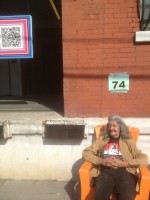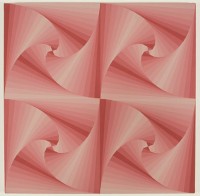Playing in Color Gradations
  By Sally Deering

British artist Peter Bill is a color illusionist and his paintings can be found in homes throughout the U.K., and U.S., and in many instances, the homes of other artists. Using subtle gradations of brilliant color, Bill can turn a color spectrum into spirals, fans – you name it, the shapes are endless, and the images seem to lift off the page like a 3-D movie but without the goofy glasses.

Bill has exhibited locally in several galleries including LITM and Cooper Gallery in Jersey City; HBO’s corporate headquarters and the Puffin Room in Manhattan; and at City Without Walls in Newark. For years, motorists have driven by the 17-foot by 15-foot peace sign he painted in the mural on Observer Highway in Hoboken. His early career work as a graphic artist can be seen in the book “The Collected Writings of Sir William Churchill,†and the three fonts he designed – Starlight, Starlight Display, and Uranus Bold – are still used today.
“Since I first began painting in the 1970s, my work has explored the relationship between color, geometry, and the flatness of the picture plane,†Bill states on his website. “For the past two years I have been working with permutations of the square. My aim is to present the many faces of the square and to make it appear as something other than what it is – a two-dimensional geometric shape. For example, by arranging subtly gradated bands of color within the boundaries of the square, I can create a concave or convex spiral. In effect, I am creating the illusion of depth while still using completely flat color…â€
A resident of Jersey City and the downtown arts district, Bill exhibits once a year because as soon as he posts a new work on his website – www.peterbill.org — someone emails him to purchase it.
Born in Glasgow, Scotland, Bill grew up in South London, England where he studied art at Camberwell School of Arts & Crafts, and City & Guilds of London Art School. He came to the New York Metro-area in 1978 and has been in Jersey City since the early 90s.
Always working on a new piece, Bill took a break from his schedule on a recent Monday evening and shared with River View Observer a little background on his artistic temperament.
RVO:Â What was it like growing up in London in the 1950s?
PB: My father was a chef at Boodles Club, a gentleman’s club in St. James. He did the party when the Duke of Edinburgh and the Queen got engaged. He went to work at the crack of dawn and came home when it was dark. Mum was a housewife. You could do it then, you can’t do it now.
RVO: When did you get interested in art?
PB: I did it as a competition thing with my sister. For me it was a struggle, art, it was something I wanted to do but didn’t know how to do it. I didn’t have the qualifications to get into art school. I started in 1964 with an apprenticeship with an engineering company that made hot and cold foil stamping machines. They did plastic cups with logos, that sort of thing I did filing, getting teas, donkey work, and occasionally they gave me something to re-touch. I started in ‘64 and left in ’72 when the company went bust.
RVO: When did you come to the states?
PB: I came here in 1978, to Spring Valley, New York. I lived in Dumont and then took a basement apartment in Edgewater. That’s when I started to paint colorful; that place was so depressing. I came to Jersey City in the 1990s. My first show here was at Traders of Babylon in Hoboken. Then I did a show in 1992 at the William Carlos Williams Center in Rutherford where I exhibited three pieces: Spirit Dancer I and II; and, Man’s Search for Peace in the Universe.
RVO: Since you don’t do a lot of exhibits these days, how do people know where to buy your work?
PB: I have the pics on my camera and I show them. I also tell them I have a payment plan.Â
RVO:  How would you describe your style? You once mentioned you try to recreate the pop of neon in your paintings?
PB: I like neon’s gradation of color, where it goes from dark to light at the center where you get that brilliance that makes the whole thing pop. The pieces undulate. I have a piece, if you stare at it, it gives the illusion that the circle is spinning. It’s like when a plane’s propeller spins one way and it spins so fast it looks like it’s going the other way, that’s what I’m trying to achieve. Simplicity is the essence of good design which is kind of my mantra when I paint.
RVO:Â How long does it take you to do a piece?
PB: It takes about a week. I give it my undivided attention because you can lose yourself very easily. That’s why all my colors are numbered.
RVO:Â Do you paint on commission?
PB:Â I paint for myself. Better for me to do something I like, instead of trying to fit into something they like.
RVO: The color changes in your paintings are so subtle – the color spectrums you paint in – you must be highly color sensitive?
PB: I play in the world of gradations. I was a black and white illustrator for many years.
For more info, go to www.peterbill.org
